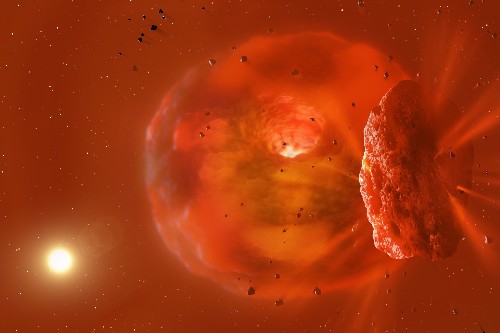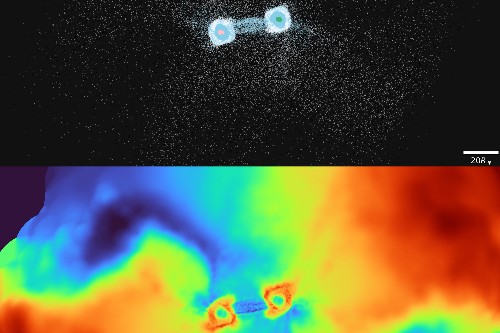| Oct 11, 2023 |
Astronomers capture first-ever afterglow of huge planetary collision in outer space
|
|
(Nanowerk News) A new study, published in Nature ("A planetary collision afterglow and transit of the resultant debris cloud"), reports the sighting of two ice giant exoplanets colliding around a sun-like star, creating a blaze of light and plumes of dust. Its findings show the bright heat afterglow and resulting dust cloud, which moved in front of the parent star dimming it over time.
|
|
The international team of astronomers was formed after an enthusiast viewed the light curve of the star and noticed something strange. It showed the system doubled in brightness at infrared wavelengths some three years before the star started to fade in visible light.
|
 |
| Image shows a visualisation of the huge, glowing planetary body produced by a planetary collision. In the foreground, fragments of ice and rock fly away from the collision and will later cross in between Earth and the host star which is seen in the background of the image. (Image: Mark Garlick)
|
|
Co-lead author Dr Matthew Kenworthy, from Leiden University, said: “To be honest, this observation was a complete surprise to me. When we originally shared the visible light curve of this star with other astronomers, we started watching it with a network of other telescopes.
|
|
“An astronomer on social media pointed out that the star brightened up in the infrared over a thousand days before the optical fading. I knew then this was an unusual event.”
|
|
The network of professional and amateur astronomers studied the star intensively including monitoring changes in the star’s brightness over the next two years. The star was named ASASSN-21qj after the network of telescopes that first detected the fading of the star at visible wavelengths.
|
|
The researchers concluded the most likely explanation is that two ice giant exoplanets collided, producing the infrared glow detected by NASA’s NEOWISE mission, which uses a space telescope to hunt for asteroids and comets.
|
 |
| Computer simulations depict the possible appearance during the collision of two icy giant planets. The top panel shows the lower hemisphere of the colliding bodies, with a cross-section through the equator revealing the atmosphere, as well as the icy and rocky layers denoted by different colours. The bottom panel represents the same simulation, with colours indicating the energies of the materials involved. These simulations uncover the generation of intense heat and bright vapor, providing insights that could aid scientists in understanding the complex light curves of the star ASASSN-21qj. (Image: Jingyao Dou)
|
|
Co-lead author Dr Simon Lock, Research Fellow in Earth Sciences at the University of Bristol, said: “Our calculations and computer models indicate the temperature and size of the glowing material, as well as the amount of time the glow has lasted, is consistent with the collision of two ice giant exoplanets.”
|
|
The resultant expanding debris cloud from the impact then travelled in front of the star some three years later, causing the star to dim in brightness at visible wavelengths.
|
|
Over the next few years, the cloud of dust is expected to start smearing out along the orbit of the collision remnant, and a tell-tale scattering of light from this cloud could be detected with both ground-based telescopes and NASA’s largest telescope in space, known as JWST.
|
|
The astronomers plan on watching closely what happens next in this system.
|
|
Co-author Dr Zoe Leinhardt, Associate Professor of Astrophysics at the University of Bristol, added: “It will be fascinating to observe further developments. Ultimately, the mass of material around the remnant may condense to form a retinue of moons that will orbit around this new planet.”
|


